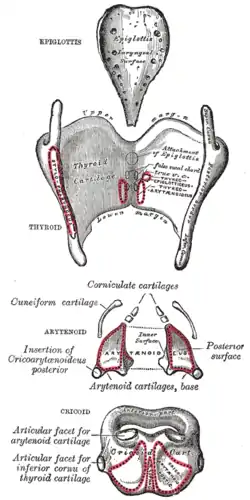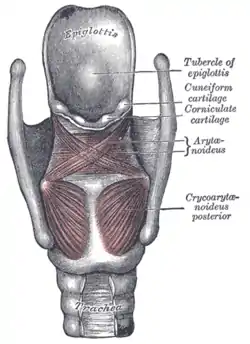Posterior cricoarytenoid muscle
The posterior cricoarytenoid muscles are small, paired intrinsic muscles of the larynx that extend between cricoid cartilage to the arytenoid cartilages in the larynx.
| Posterior cricoarytenoid | |
|---|---|
 Muscles of larynx. Side view. Right lamina of thyroid cartilage removed. | |
| Details | |
| Origin | posterior part of the cricoid |
| Insertion | posterior surface of muscular process of the arytenoid cartilage |
| Nerve | recurrent laryngeal nerve branch of the vagus |
| Actions | abducts and laterally rotates the cartilage, pulling the vocal ligaments away from the midline and forward and so opening the rima glottidis |
| Antagonist | Lateral cricoarytenoid muscle |
| Identifiers | |
| Latin | Musculus cricoarytaenoideus posterior |
| TA98 | A06.2.08.004 |
| TA2 | 2196 |
| FMA | 46576 |
| Anatomical terms of muscle | |
Structure
Origin and Insertion
The posterior cricoarytenoid originates from the posterior surface of the posterior quadrate lamina of the cricoid cartilage. It inserts onto the posterior surface of the muscular process of the arytenoid cartilage.
Nerve supply
The posterior cricoarytenoid muscles are innervated by the recurrent laryngeal nerve, a branch of the vagus nerve (CN X).
Function
The posterior cricoarytenoid muscles are the only muscles to open the vocal cords. By rotating the arytenoid cartilages laterally, these muscles abduct the vocal cords and thereby open the rima glottidis.[1] :9 Their action opposes the lateral cricoarytenoid muscles.
Clinical significance
Paralysis of the posterior cricoarytenoid muscles may lead to asphyxiation as they are the only laryngeal muscles to open the true vocal folds, allowing inspiration and expiration.[2]
Additional images
 The cartilages of the larynx. Posterior view.
The cartilages of the larynx. Posterior view. Muscles of larynx. Posterior view.
Muscles of larynx. Posterior view. Muscles of the larynx, seen from above.
Muscles of the larynx, seen from above. Dissection of the muscles of the palate from behind.
Dissection of the muscles of the palate from behind. Posterior cricoarytenoid muscle
Posterior cricoarytenoid muscle Posterior cricoarytenoid muscle
Posterior cricoarytenoid muscle Posterior cricoarytenoid muscle
Posterior cricoarytenoid muscle
See also
| Wikimedia Commons has media related to Posterior cricoarytenoid muscle. |
References
- Hydman, Jonas (2008). Recurrent laryngeal nerve injury. Stockholm. ISBN 978-91-7409-123-6.
- The Arytenoid Cartilages - a clinical overview. 2002, Dr. C Kay et al. Thorne Publishing (C)
External links
- Atlas image: rsa4p2 at the University of Michigan Health System
- lesson11 at The Anatomy Lesson by Wesley Norman (Georgetown University) (larynxmuscles)